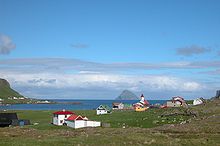Hvalba
|
||

|
||
| position | 61 ° 36 ' N , 6 ° 57' W | |
|
Resident rank |
723 (2011) 17 |
|
| Commune | Hvalbiar communa | |
| Post Code | FO 850 | |
| Markatal | 98-13-00 | |
|
Grammar dative (in / from ...) genitive (after ...) |
í / úr Hvalba til Hvalbiar |
|
Hvalba [ ˈkvalba ] (old spelling Hvalbø , literally "whale field") is a place in the Faroe Islands in the north of the east coast of Suðuroy .

The municipality of Hvalba includes the place Sandvík in the far north of the South Island and the uninhabited island of Lítla Dímun in front of it . At the end of 2002 the municipality had a total of exactly 767 inhabitants. Geographically, Hvalba is located on a 2 km narrow isthmus , Norðbergseiði , and has access to both the west and east coast of the island. The actual settlement is located around the bay at Hvalbiarfjørður on the east coast. The football club of Hvalba is royn hvalba .
economy
As the place name Hvalba ( whale field ) suggests, this extensive sandy bay is an ideal place for the grindadráp , which is only allowed to take place in places where the pilot whales can be stranded. Accordingly, Hvalba appears frequently in the statistics of pilot whales in the Faroe Islands through the centuries as one of the table leaders.
The second part of the place name comes from bøur (cultivated field, Innmark, Flur ). Indeed, Hvalba has one of the largest arable land in the Faroe Islands, and local farmers are known to be particularly hardworking.
A third economic factor in the past was lignite mining south of Hvalba since the 1770s , which played an important role for the entire country during the British occupation of the Faroe Islands in World War II . The largest annual production was achieved in 1958 with 18,000 t. There are still four miners who are paid by the state working in the mine . Every year they mine around 1000 tons of coal. Almost all of the coal for the rest of the Faroe Islands was shipped from Hvalba.
The coal seams are very low powerful and the only fossil energy sources of the Faroe Islands.
In keeping with its economic importance, Hvalba is not only relatively populous, but was also the first place in the Faroe Islands to be connected with a road tunnel in 1963 (after Trongisvágur / Tvøroyri ). In 1969 the second tunnel to Sandvík followed .
History and sights
In 1629 the place was haunted by 500 pirates from Algeria who came with three ships. They pillaged the village, killed six men and abducted 30 women and children who were sold as slaves in North Africa. In the same year, two pirate ships are said to have been shipwrecked in the fjord near Hvalba and were shattered by the surf. It is said that around 300 bodies were driven ashore. On the bank there is a place called turkargravir ( Turkish tombs) by the locals . In 1802 Hvalba had 202 inhabitants and was the second largest town in the Faroe Islands after Tórshavn.
The last remaining coal mine in the Faroe Islands can be visited a few kilometers south of Hvalba.
As in every place in the Faroe Islands, there is also a memorial in Hvalba for the seamen who died at sea. It is at the end of the village on the road to Sandvík. It also contains the names of four miners who died in the lignite mines in Hvalba in 1835, 1944, 1946 and 1957.
The church is also worth seeing. In 2014 it was decided to create a forest on the western edge of the village.
Grindadráp in Hvalba
Hvalba and Lítla Dímun
Hvalba / Nes and Stóra Dímun
Debris heaps mark the mouth holes of the former Stollnbergwerke
Oral hole of a former mine
Web links
- Hvalba . Faroeislands.dk, info and photos (English)
Individual evidence
- ↑ us.fo ( Memento from November 6, 2014 in the Internet Archive )










